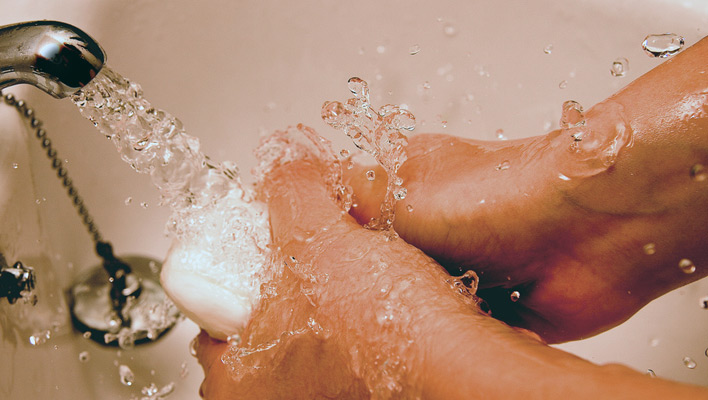When we think about toxins in a marine aquarium, the first thing that usually comes to mind is ammonia or a toxic allelopathic chemical released by a coral—in other words, a biologically produced toxin originating in the tank itself. But sometimes hobbyists are unwitting sources of harmful compounds or pathogens from outside the aquarium.
As one might well imagine, accidental contamination of an aquarium can potentially harm or even kill valued specimens. The trouble is, there’s no practical way for hobbyists to test for most contaminants, so it’s often impossible to determine the cause of the “anomalous” illness or losses in such instances.
The old proverb “An ounce of prevention is worth a pound of cure” definitely applies here, so let’s look at some of the preventive measures you can take to keep your saltwater system free of external contaminants:
Avoid toxic handiwork
Hobbyists’ hands are probably the most common mode for transferring contaminants into aquariums. After applying lotion, handling garden chemicals, pumping gas, waxing your car, cleaning the tub, polishing the silverware, or otherwise contaminating your hands, it’s all to easy to completely forget and then absentmindedly reach right into your aquarium to rearrange or retrieve something.
It’s wise to develop the habit of washing your hands (taking care to rinse the soap off thoroughly, of course) before reaching into the tank for any reason. If necessary, post a small reminder note on or near the tank that reads, “Have you washed your hands?”
Ideally, you should avoid putting your hands in the tank unless it’s absolutely necessary anyway (whenever possible, use aquarium-safe tongs for righting or removing objects from the tank). If you must use your hands, it’s a good idea to wear protective gloves.
Keep the spray at bay
Cleaning sprays, cooking sprays, pesticides, room deodorizers, and other finely aerosolized products/chemicals can drift over your aquarium and then settle onto the water. Some of these chemicals can prove deadly to fish and/or invertebrates. Others may form a film on the water surface that interferes with proper gas exchange. Avoid using any such sprays near your aquarium or even in adjacent areas if there’s any possibility that the airborne product will drift into the vicinity of the tank.
Implement a smoking ban
I’ll admit to enjoying an occasional cigar (preferably from JC the Cuban Roller in St. Augustine, Florida)—but only outdoors where there’s no chance the smoke can reach my aquariums. I don’t know what (if any) effect tobacco smoke might have on marine fish and inverts, but why take a chance? If any smoker tries to light up around your aquarium, send him or her packing (pun intended)!
Prevent tank-to-tank contamination
Quarantining new specimens is vital if you want to prevent the accidental introduction of disease to an established aquarium. But even the most conscientious in this regard can occasionally stumble and forget that using the same aquarium brush, tongs, scraper, or other tool in both the quarantine tank and display tank can transfer a pathogen or parasite from the former to the latter.
It’s the wise hobbyist who keeps two complete sets of aquarium tools—one for quarantine and the other for the display system. If necessary to keep the two sets of tools from getting mixed and mingled, clearly mark one set in some manner, for example, by wrapping the ends of the tool handles with colored tape.




The last time I painted my house I put a cover on the tank and put an airpump outside so it sucked air from outdoors. I just ran an airline to the tank. With the modern water paints that is not necessary any longer. And although I don’t smoke, I do have a smoking ban in my house for every one. But I can’t keep my firefish from lighting up.
Those darn firefish are like smokestacks…
A couple of thoughts: When painting a room in the house take great care to avoid the fumes in the rom your tank, or tanks, are located. Also even if a smell does not seem too potent, remember that if you run a skimmer it is possibly concentrating any fumes in the water.
Both good points, Matt! When painting in or near your fish room, the more ventilation you can provide, the better, and it might be wise to unplug the skimmer until the fumes clear. Thanks for this input!